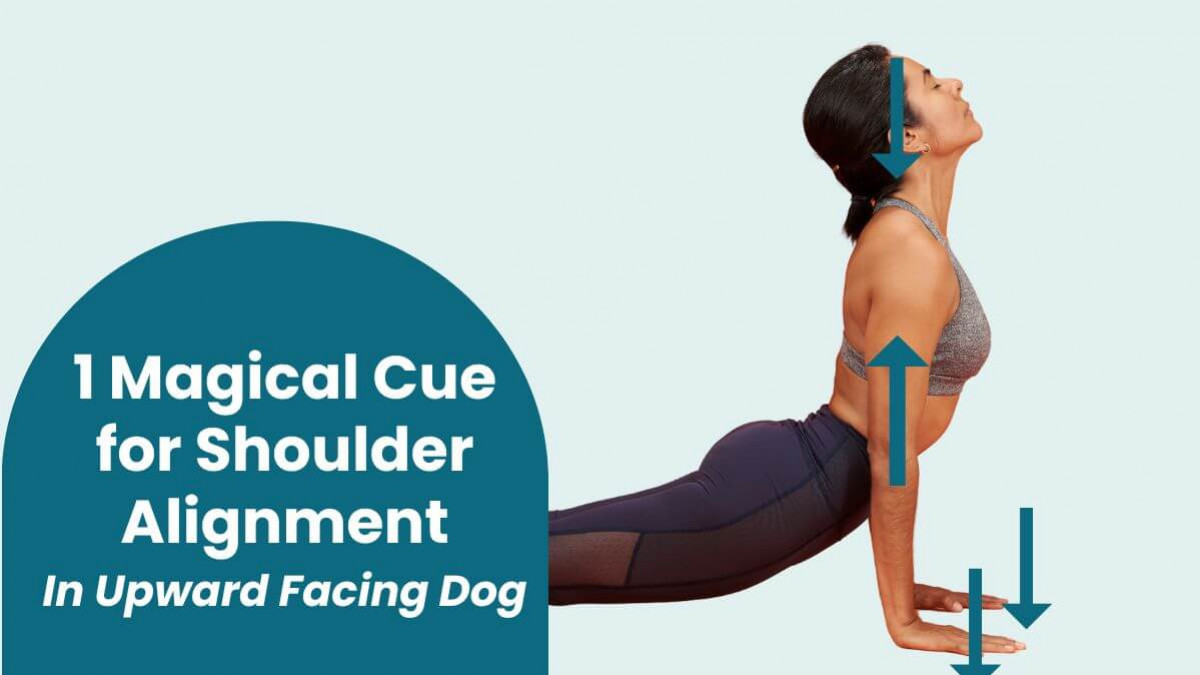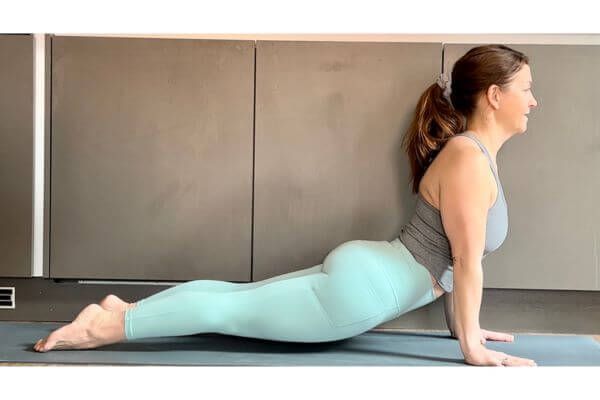One Magical Cue For Shoulder Alignment in Upward Facing Dog

Learn the one cue that can align the shoulders in upward facing dog.
What if just one simple cue can change the shoulder alignment in upward facing dog?
.
There is a delicate balance between guiding students effectively and overwhelming them with too much information.
.
Do you find yourself grappling with the challenge of simplifying complex anatomical cues, particularly when it comes to shoulder alignment?
.

.
It’s common to see students with their shoulders up by their ears in upward facing dog. And therefore, it’s also common for yoga teachers to wonder what to say to help them obtain better alignment and experience the posture with more ease. Let’s face it, many yoga teachers get confused here, because the biomechanics of the shoulder are complicated!
.
This is why I want to share the One Magical Cue for shoulder alignment in upward facing dog.
.
And guess what? The magical cue does not even speak to the shoulder! Here it is....
.
"Press the four corners of your down hands into the mat."
.
I have consistently used this cue for over ten years and it keeps proving to be one of the most effective cues I use!
This seemingly simple instruction is a game-changer in enhancing shoulder alignment and stability. Let's unpack the magic behind this cue.
.
Start with the Foundation:
When you observe the alignment of a student in a yoga posture, start with the foundation. If you’ve read my other articles or taken my courses, you likely know this principle. The foundation is what’s touching the ground. The rest of the posture is supported by the foundation. In upward facing dog, the foundation is the hands and the tops of the feet.

The cue to “press the four corners of your hands down into the mat” fosters a sense of rootedness, and it also serves as a gateway to deeper embodiment and awareness on the mat.
The cue is simple and accessible. Unlike more abstract cues that can lead to confusion or misinterpretation, the instruction to press the hands down into the mat is tangible. Students understand the cue because they know where their hands are, and they know where the mat is. By directing their attention to the physical sensation of their hands connecting with the mat, students get present and clear.
.
At this point, you might agree that a cue to the hands on the mat is easy to follow, but why would you cue the hands if you see the misalignment in the shoulders?
.
The cue to “press the four corners of your hands down into the mat” not only creates connection to the Earth, it makes a big impact on the shoulders!
When the hands are weight-bearing as they are in upward facing dog, any movement or action initiated through them inevitably influences the shoulders. Let's take a closer look.
.
Engagement of Shoulder Stabilizers:
To start, understand that pressing into the hands activates the muscles surrounding the shoulder joint. These muscles work together to stabilize the shoulder girdle. And stability is so important when there is weight on shoulders.

.
Alignment of the Shoulders:
Let’s take a closer look at what is happening when someone is in upward facing dog with their ears up by their shoulders. If the ears are up by the shoulder the shoulder blades are elevated.

.
If the hands are on the ground and you press down into the hands, the muscles of the arms and shoulders will activate to create shoulder blade depression. And shoulder blade depression is what is needed to move the shoulders away from the ears in upward facing dog.
.

There are a lot of other cues that speak to the shoulders to obtain improved alignment. I recently heard a well known yoga teacher providing cues to bring the shoulders away from the ears and included the following:
- “Roll your shoulders up and back, then down.”
- “Bring your shoulder blades down your back.”
Hear me out here. There is nothing wrong with these cues and they could be useful. I just got into upward facing dog and tried them out. They did give me some positive changes. But ultimately, my shoulders still felt tight and cramped up by my ears a bit. I reset into a “lazy” upward facing dog with my ears way up by my shoulders. Next I integrated the cue to press the four corners of my hands down into my mat.
.

.
I could feel the muscles throughout my arms and shoulders activate. I could also feel muscles in my core activate. And most importantly, my shoulders moved away from my ears.
.
Overall, pressing into the hands in a weight-bearing position promotes shoulder stability, shoulder blade control, and even core engagement. These things lead to improved posture and biomechanical efficiency.
You don’t necessarily have to throw away those other cues. However, consider the impact of the one magical cue!
.
“Press the four corners of your hands down into the mat.”
.
By encouraging students to press down through the four corners of their hands, they activate a chain reaction of muscular engagement that extends through the arms and into the shoulders, promoting stability and integrity throughout the upper body.
.
If you want students to understand your cues, keep them simple. Avoid too many complicated alignment cues and speak to what will make the biggest difference.
.
Give the “one magical cue” for the shoulders a try in your own upward facing dog. Repeat a few times and observe what you feel. Then take this simple and magical cue into your classes and observe the impact it makes on the students in your class!
.

.
If you're ready to take your cueing to the next level, I invite you to download my list of 16 Anatomy-Informed Yoga Cues to Start Using Right Now.
.

.

If you're eager to expand your toolkit of anatomy cues, grab the Free Yoga Teachers Cheat Sheet: 16 Anatomy Informed Cues to Use Right Now. It's packed with anatomy informed cues that I have refined using my twenty+ years experience as a doctor of physical therapy, an anatomy professor, and a yoga teacher.
These are the exact cues I use in my yoga anatomy courses and yoga teacher trainings to ensure teachers are confident with teaching anatomy informed yoga!
Go from “I can’t learn anatomy” to teaching anatomy informed yoga classes. Your students will not only feel safe, but excited to learn from you and keep coming back!
Categories: : Cues, Effective Teaching Techniques, Shoulders, Upward Facing Dog
 Trish Corley
Trish Corley 
